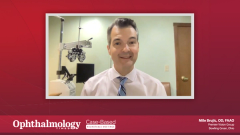
Approaches to Managing Post-Operation for Dry Eye Disease
Mile Brujic, OD, FAAO, discusses the use of specialty lenses vs glasses in some patients, as well as approaches to managing the symptoms of dry eye disease.
Mile Brujic, OD, FAAO: As we went through the case that we just talked about, we realized there were some things that we expected to see, and there were some things that we didn’t expect to see. And I think when we think about our patients, we always need to make sure [to think about] key considerations as we’re managing our patients. We always need to make sure that we’re keeping our blinders [off] and make sure that we’re looking at this patient holistically. Because the patient that I just shared with you, she was just interested in updating her glasses in hopes of improving her vision. Well, the reality was, there were 2 limiting factors that were preventing her from improving her best corrective vision. One was highly irregular epithelial thickness maps, which is a technology that some of you may have in your practice, but certainly is available on advanced anterior segment OCT [optical coherence tomography] designs currently. The second thing is, is maybe glasses aren’t always the best option to optimize vision because of this, and maybe leveraging specialty lenses can get these patients just simply functioning better. And the third and most important thing is now how do you manage an individual’s symptoms and signs of dryness in the area of concurrent post-operative findings like we saw with this individual?
This case really highlighted a lot of things. When I think back on the case, and I think about what things that kind of stand out about this case, there are a few things. One is the low level of inflammation that we found on the ocular surface represented by a negative inflammatory response and [the other is] the influence that the lids can have on the ocular surface with inappropriate lid seal with things like incomplete blinks, loose lid apposition. Not a true floppy eyelid, but loose lid apposition is one of those things that can challenge a patient’s viability for an appropriate ocular surface and just simply inappropriate spreading of the tear film. So this case really highlighted all of those and gave us a treatment strategy and perspective on how we can make this patient better. So when we think about the rationale, we took a step back when we looked at this patient and we said, how can we make this better and leverage the benefits of our specialty lenses and also some of the procedures that we have the ability to do in our practice to really optimize outcomes for this patient? And what we did was we looked at the negative inflammatory outcomes. We realized that maybe this patient would benefit from punctual occlusion. Certainly, if those inflammatory readings were elevated, this would be further down the therapeutic regimen. But it made sense in this individual’s instance, in particular because of the amount of times that she was [having] dry eye, the amount of complaints that she was having from fluctuating vision. The real icing on the cake here was that we not only improved the patient’s vision, but we significantly improved her best corrected visual acuity, which, immediately leaving the day that she picked up her scleral lenses, made her vision sharper for her so she could function at everything she was doing. But more importantly, the dryness that we were managing was immediately improved from a signs and symptoms perspective. And I think the key takeaways from this case are, 1, make sure that when you have technologies in your practice, you’re thinking about how you can leverage and utilize those technologies to identify patients that would benefit from you, as a clinician, knowing about things that may be abnormal, by the utilization of these technologies in helping you see the abnormalities better, specifically the epithelial thickness maps. I think the other thing, too, is it gives us perspective around how we might be able to leverage several treatment options to optimize best patient outcomes. And although this was a dry eye patient that we were highlighting, there were also other areas of this patient’s life that we improved specifically through the combination of the dry treatments that we have, plus the specialty lens options that we have.
Thank you for watching this Ophthalmology Times presentation. We hope you found this presentation informative and applicable in your practice.
Transcript is AI-generated and edited for clarity and readability.
Newsletter
Don’t miss out—get Ophthalmology Times updates on the latest clinical advancements and expert interviews, straight to your inbox.






